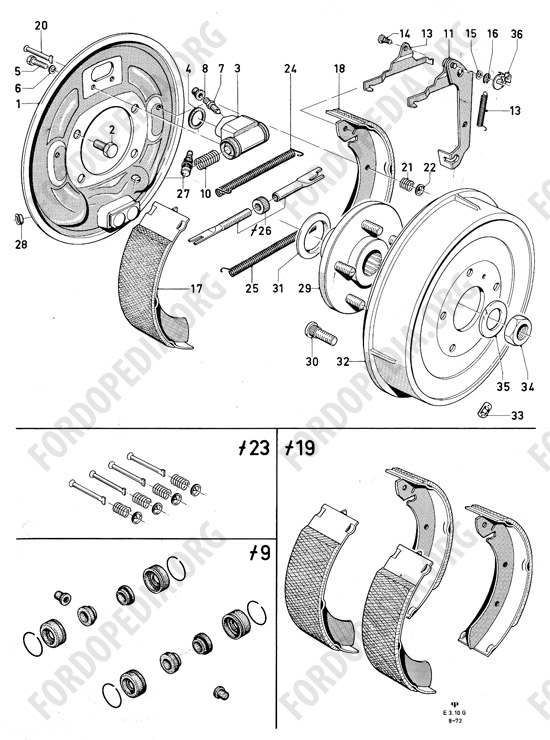eurogranada
Europe
To tinker or not to tinker, that is the question...
Posts: 2,556
|
|
|
|
Looking back through the pages...I see this; 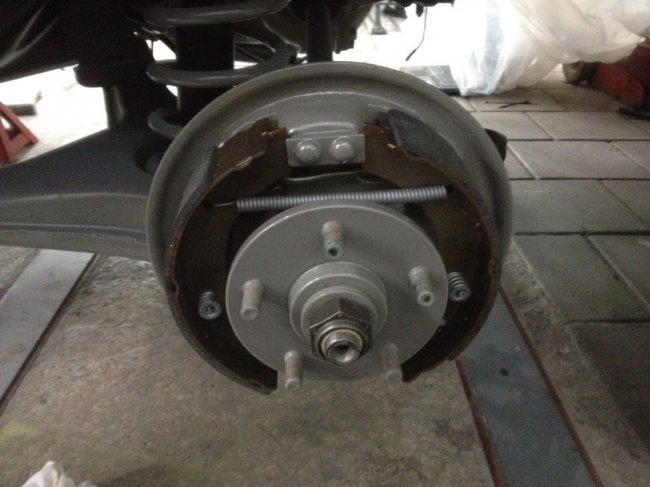 Now, it's been ages since I worked on Granada brakes but all other classic Fords I have worked have the brake cylinder on top, not on the bottom like you have them. From memory, putting that would not make the bleed nipple the highest point of the rear brakes meaning you may have a hard time getting the air out. The Motomobil parts diagram also show the wheel cylinder on top. Worth checking at least. I couldn't find any pictures of the front calipers but as I mentioned earlier - make sure they are on the correct side, with bleed nipple at the top. We just made that mistake on the race car a few weeks ago... Regards Gustaf You are right, I've asked around before... My car has always had the wheel cylinders on the bottom, so that is how I put it back together as well. I had noticed that that other granada's (mainly later years though) had them on the top. Also the new hardlines I got would not reach the top location so that to me confirmed that I had my system right. Also never had problems bleeding the brakes before, but that may also be due to the fact it has never before been completely empty, like it was now... It'll be a bear of a job, but I can change it around if all else fails. See how it was when first taken off the car and put back during initial technical restoration. You'll clearly see how the cylinders are mounted in the low position. I got them bled easlily enough that time. But the hardlines weren't touched... 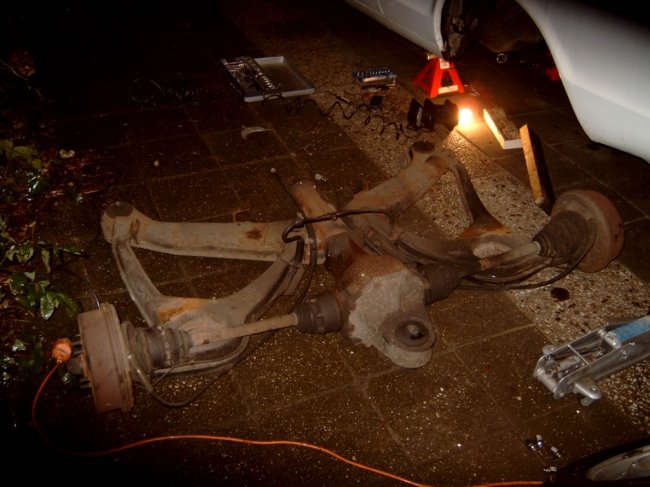 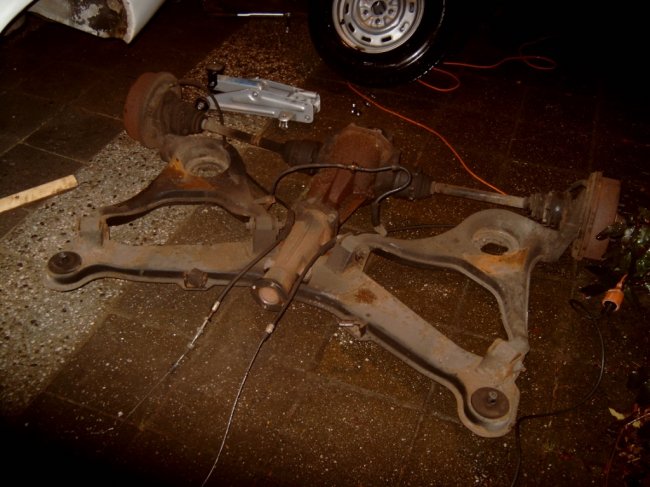 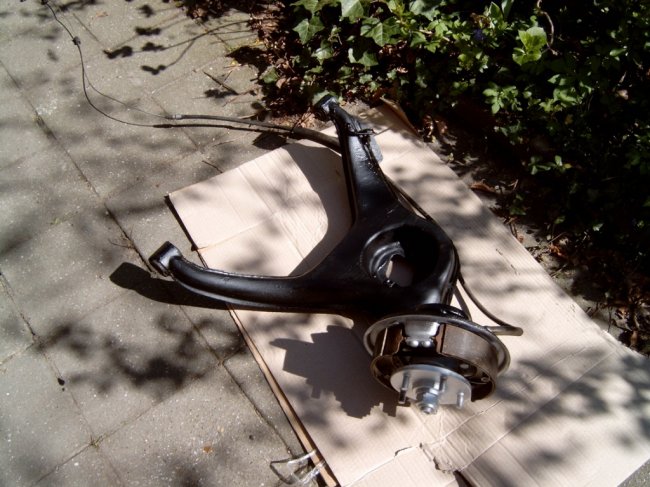 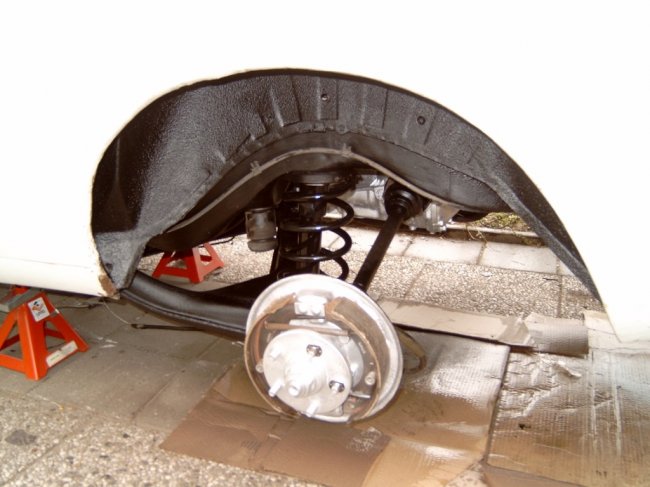 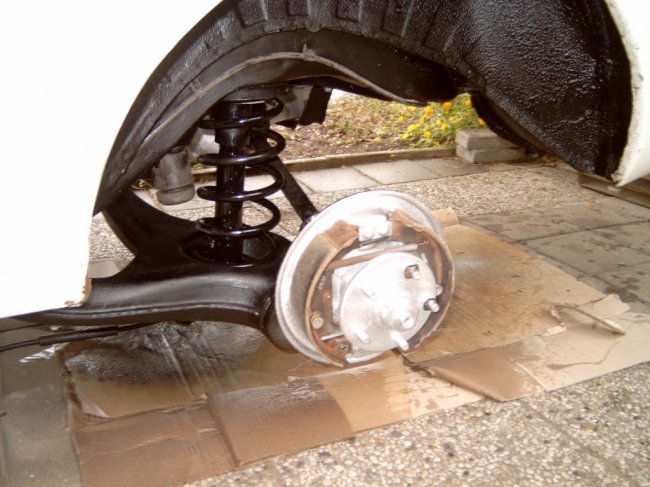 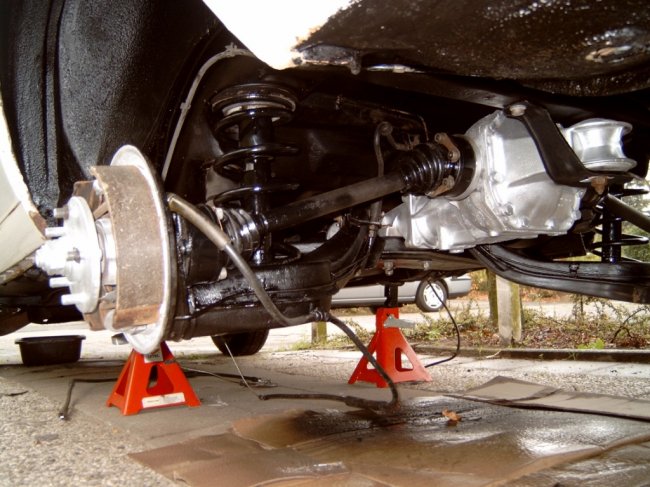  Edit: calipers have the nipples on top. |
| |
|
|
|
|
eurogranada
Europe
To tinker or not to tinker, that is the question...
Posts: 2,556
|
|
|
|
My information and research shows ford changed this over at some point. I believe my parts book actually shows this. And I've just added pictures as well... The car never before had problems with the brakes and as long as Ihad it, the cylinders were in the low position. Also, I've had a spare axle with the brakes the exact same way. Also, the Motomobil hardline set you buy for the Mk1 has all lines included, but the ones for the rear really won't make it to the top. 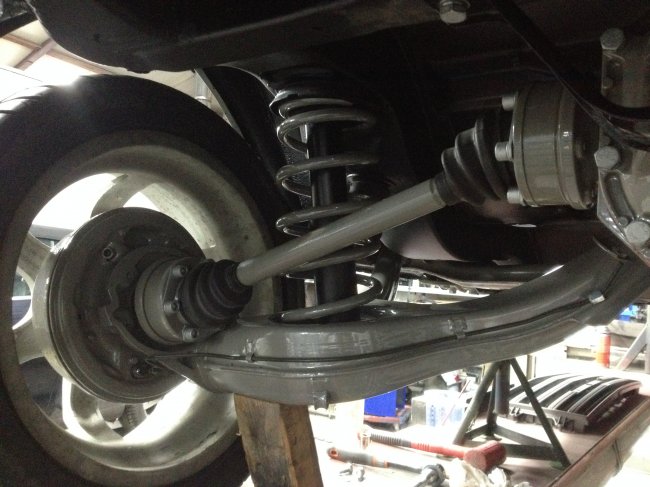 As you can see there is a litle extra line for the lower position, but there is by far not enough line to make it to the top. Also this motomobil picture shows the hardlines going to the LOW end as well. Also on the same page is the emergency/hand brake cable show, THAT goes top the TOP as well, just as on my car. Still with the backplates switched sides, the e-brake would come down with the cylinder up. But that still leaves the brake lines too short. 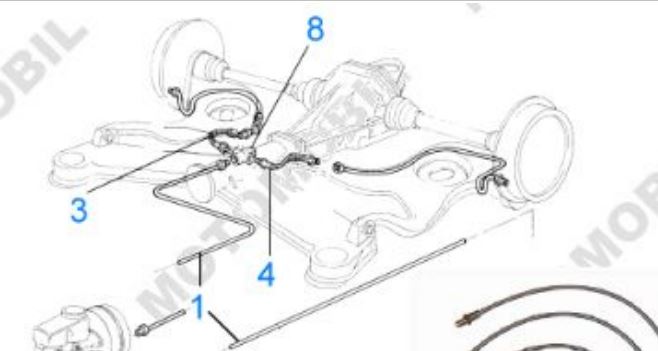 Whichever way may be better, the fact is the system worked excellent before the restoration (less than 6% difference) so it should be able to now as well. This is not the "AHA" discovery it's made out to be... Edit: Although this may be of influence on the ease of bleeding, that I can't dismiss. |
| |
|
|
|
|
|
|
|
|
are you bleeding with the car in the air and the wheels at full drop? if that is the case then the wheel cylinders are going to be the lowest point of the system, making it difficult to get all of the air out. Any air is going to want to sit in the flexy lines above the differential.
|
| |
|
|
eurogranada
Europe
To tinker or not to tinker, that is the question...
Posts: 2,556
|
|
|
|
are you bleeding with the car in the air and the wheels at full drop? if that is the case then the wheel cylinders are going to be the lowest point of the system, making it difficult to get all of the air out. Any air is going to want to sit in the flexy lines above the differential. I've bled the brakes with the car on the ground the last couple of runs, so also with the new MC. The very first one was initially with the wheels off the car and the car on stands, but when brakes were found inadequate they were rebled on the ground. Never thought it would matter anyway. I would expect the fluid wich seems denser then air to push the air out (especially at 2bar pressure). As I'm getting no air at the wheels, that would mean the fluid somehow works it's way past the trapped air by passing underneath it?? And this is for all those trying to be of help: STILL, I'D LIKE TO JUST SAY I APPRECIATE THE HELP! I REALLY DO! I APPRECIATE PEOPLE EVEN GOING BACK THROUGH MY THREAD AND COMING UP WITH POSSIBLE CAUSES. I typed this in caps not to be rude, but to make sure everyone gets this. Cause I know me dismissing some of the offered up causes can be taken the wrong way. That is not my intention at all. And not the case either. I take it as welcome advice, but I also like to clarify that even if it isn't right, this system has worked perfectly before with the exact same layout. It was actually complimented on from the MOT tester. |
| |
|
|
gess
Part of things
 
Posts: 220 
|
|
|
|
|
The Mk1 Granadas had the wheel cylinders at the bottom, as it is on your car. This was altered on later models, I think in 78 with the introduction of the Mk2. It is not just a matter of turning the back plates upside down as the hole pattern for the bolts is different from top to bottom. You will have to source Mk2 back plates. Another difference is the handbrake cable, it is placed on top of the rear beams on the Mk2 not along the edge as it is on your car. It is possible to rebuild, but it takes a bit of engineering.
|
| |
|
|
|
|
|
|
|
|
I know this is probably curse word, but I took my then Land Rover 90 in for MoT. It failed on emissions and brakes, although I did have good pedal, it was longer than it should be (in hindsight) although that's how it had always been in the couple of months I'd had it. And because Land Rover.
The MoT guy was a mate of mine so we set about looking. On the 90 the servo pipe came off No.4 cylinder inlet manifold so we started looking there. Turns out there was an air leak on the intake manifold gasket which a) made the emissions lousy and b) sent virtually no vacuum to the servo. To me, the latter should have resulted in a harder pedal, but no, it would head for the floor before anything happened. New intake gasket and problem solved.
Just a thought.
|
| |
|
|
eurogranada
Europe
To tinker or not to tinker, that is the question...
Posts: 2,556
|
|
|
|
The Mk1 Granadas had the wheel cylinders at the bottom, as it is on your car. This was altered on later models, I think in 78 with the introduction of the Mk2. It is not just a matter of turning the back plates upside down as the hole pattern for the bolts is different from top to bottom. You will have to source Mk2 back plates. Another difference is the handbrake cable, it is placed on top of the rear beams on the Mk2 not along the edge as it is on your car. It is possible to rebuild, but it takes a bit of engineering. Nice to have a confirmation! Thanks for your input once more. The goal will be to get this system working right. And I'm sure fresh eyes and SamJ's help will get me further along! |
| |
|
|
eurogranada
Europe
To tinker or not to tinker, that is the question...
Posts: 2,556
|
|
|
|
I know this is probably curse word, but I took my then Land Rover 90 in for MoT. It failed on emissions and brakes, although I did have good pedal, it was longer than it should be (in hindsight) although that's how it had always been in the couple of months I'd had it. And because Land Rover. The MoT guy was a mate of mine so we set about looking. On the 90 the servo pipe came off No.4 cylinder inlet manifold so we started looking there. Turns out there was an air leak on the intake manifold gasket which a) made the emissions lousy and b) sent virtually no vacuum to the servo. To me, the latter should have resulted in a harder pedal, but no, it would head for the floor before anything happened. New intake gasket and problem solved. Just a thought. Thanks for that. I'll see what I can make of this in relation to my car. I still think adding the scorpio one way valve may also be wise. So you may be onto something. |
| |
|
|
scimjim
Club Retro Rides Member
Posts: 1,503
Club RR Member Number: 8
|
|
|
|
|
Just a thought - you are convinced it's air in the system but I can't see any reference to the first check for air - pumping the pedal?
Apologies if I've missed it but you may be going down a rabbit hole. I have larger bore MC and rear cylinders on one of my cars and it has a "longer" pedal but still bites well at the bottom
|
| |
|
|
|
|
|
|
|
|
OK, that just shows how little I know about MkI Granadas ;-)
Are the wheel cylinders the same? No risk of having them upside down? The brake lines should be OK running above the cylinders as long as the bleed nipple is high enough in the cylinder.
Gustaf
|
| |
|
|
eurogranada
Europe
To tinker or not to tinker, that is the question...
Posts: 2,556
|
|
|
|
Just a thought - you are convinced it's air in the system but I can't see any reference to the first check for air - pumping the pedal? Apologies if I've missed it but you may be going down a rabbit hole. I have larger bore MC and rear cylinders on one of my cars and it has a "longer" pedal but still bites well at the bottom With the pumping the pedal reference, what are you looking for exactly? I tried pumping the pedal fast, with engine running, but it does not seem to improve at that time. But generally speaking I feel like the pedal is sucked down pretty hard by the vacuum booster. I believe with engine off it felt possibly a little better for a very short period of time... very short. But to be honest, I've been working on them for so long that I think fresh eyes should answer these kind of questions. I hope saturday we will have a good session troubleshooting the brakes. |
| |
|
|
The Doctor
Club Retro Rides Member
Posts: 3,446
Club RR Member Number: 48
|
|
|
|
Another thing you could try if the rear cylinders are the problem is to take them out, turn them 'upside down', clamp them and then bleed. Refit after bleeding right way up. That's how my mate used to do it with his car, which had the wrong wheel cylinders as he found the right ones to expensive  If you clamp of the rear flexi's and have a hard pedal then, it could point to air trapped in the rear system, The fact that Ford changed the system could point to it being a better system with the cylinders on top. |
| |
|
|
eurogranada
Europe
To tinker or not to tinker, that is the question...
Posts: 2,556
|
|
|
|
OK, that just shows how little I know about MkI Granadas ;-) Are the wheel cylinders the same? No risk of having them upside down? The brake lines should be OK running above the cylinders as long as the bleed nipple is high enough in the cylinder. Gustaf Wheel cylinders are the same. Upside down I don't think so. The bleed nipple faces the rear of the car and the feed line is in front of that. Seems more logicat as the bleed nipple would otherwise be hard to reach. The bleed nipple is on the same level as the line feeding the cylinder. The pics I think show a little dip below cylinder level in the line to get the line to the cylinder... They're not too clear and I don't have it in my head right now. |
| |
|
|
scimjim
Club Retro Rides Member
Posts: 1,503
Club RR Member Number: 8
|
|
|
|
With the pumping the pedal reference, what are you looking for exactly? Air will eventually compress and give you a firm pedal - which will disappear as soon as you lift your foot off I tried pumping the pedal fast, with engine running, but it does not seem to improve at that time. Doesn't sound like air to me then? But generally speaking I feel like the pedal is sucked down pretty hard by the vacuum booster. This suggests a master cylinder problem (or linkage) to me? the servo shouldn't pull the pedal down. Do you have an adjustable MC input shaft? |
| |
|
|
eurogranada
Europe
To tinker or not to tinker, that is the question...
Posts: 2,556
|
|
|
|
With the pumping the pedal reference, what are you looking for exactly? Air will eventually compress and give you a firm pedal - which will disappear as soon as you lift your foot off I tried pumping the pedal fast, with engine running, but it does not seem to improve at that time. Doesn't sound like air to me then? But generally speaking I feel like the pedal is sucked down pretty hard by the vacuum booster. This suggests a master cylinder problem (or linkage) to me? the servo shouldn't pull the pedal down. Do you have an adjustable MC input shaft? Well, as I said, someone else should really judge the workings of the pedal as I'm biased I guess. But given your description I could still not dismiss this. The pedal is just so far down that it's hard to pump it up quick enough to judge this properly I think. There may also still be just too much air to compress fast enough? I do not believe that of the three different MC's I've had on, two rebuilt, one brand spanking new (never pedal pumped to the end etc), all would be defective. I guess we'll do the checks saturday, but that to me is unlikely. With sucked down I mean there is so little effort required to push the pedal. The vacuum operated booster seems to do a very good job of assisting. It's not actually sucking it down as far as I can tell. But it is why I'm contemplating adding the original scorpi one way valve to the air line to booster that is now only using the original granada valve. I hope I can put everyone's theories to the test and to rest after a session on the brakes with a fresh pair of eyes. |
| |
|
|
stealthstylz
Club Retro Rides Member
Posts: 14,954
Club RR Member Number: 174
|
|
|
|
|
I haven't got time to look back through the thread - have you checked the brake master cylinder pushrod is adjusted correctly? Might not be long enough so it's not pushing the piston in far enough.
|
| |
|
|
eurogranada
Europe
To tinker or not to tinker, that is the question...
Posts: 2,556
|
|
|
|
I haven't got time to look back through the thread - have you checked the brake master cylinder pushrod is adjusted correctly? Might not be long enough so it's not pushing the piston in far enough. No worries, reading back is quite a chore! ;-) But yes this has been covered... A. the pushrod on the Granada is not adjustable B. the pushrod was confirmed to have the exact amount of travel the innards of the MC also have (max pedal = max movement mc) C. The pushrod connection to the pedal fell exactly into place without any manipulation |
| |
|
|
gess
Part of things
 
Posts: 220 
|
|
|
|
Here is a fancy bleed nipple for you :-) www.stahlbus.com/products/en/bleeding-system/index.phpYou have written a bit about the brake pedal being switched from manual to auto pedal. The auto pedal is from a Granada isn't it? In my experience they have identical connection points and method, and the only difference is the part where you put your foot, it is larger on the auto pedal. I have changed from auto to manual transmission on a Granada, and we just changed brake pedal and installed a clutch pedal onto the existing pedal assembly in the car. No problems whatsoever. |
| |
|
|
eurogranada
Europe
To tinker or not to tinker, that is the question...
Posts: 2,556
|
|
|
|
Here is a fancy bleed nipple for you :-) www.stahlbus.com/products/en/bleeding-system/index.phpYou have written a bit about the brake pedal being switched from manual to auto pedal. The auto pedal is from a Granada isn't it? In my experience they have identical connection points and method, and the only difference is the part where you put your foot, it is larger on the auto pedal. I have changed from auto to manual transmission on a Granada, and we just changed brake pedal and installed a clutch pedal onto the existing pedal assembly in the car. No problems whatsoever. That is exactly why I'm pretty sure the conversion from manual to auto has nothing to do with the issue. But as that is the only point where the pushrod is concerend, it's logical to make sure. But I'm absolutely confident the pedal is fine. |
| |
|
|
|
|
|
Jun 10, 2016 11:14:41 GMT
|
|
Can I just say I keep coming back to this as I want to see it resolved! I can't offer any advice but I am heartened that so many people are trying their best to help eurogranada with some real in depth knowledge and experience. All good natured and respectful too.
This is what is so great about the internet forums, this one in particular.
|
| |
The Millenium Volcon"Get yourself a Volvo if that's what you really want, you might be dead next year. In the meantime, you could be going sideways in a gigantic land barge."
|
|














